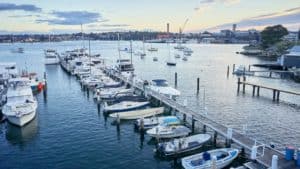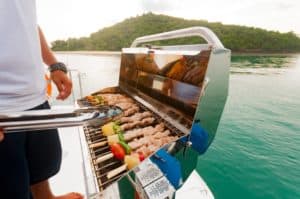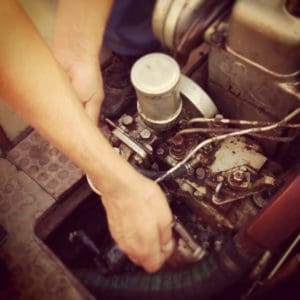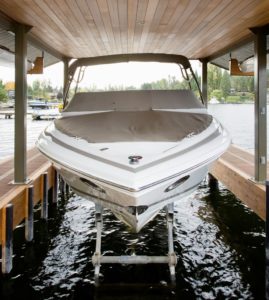Anchoring your boat is an essential seamanship skill that every boater should learn. We’ve put together a helpful guide detailing basic anchoring techniques and tips so you can set anchor with confidence.
Let’s get started.
How Anchors Work
Anchors allow you to secure your boat in a safe location, keeping it out of the surf or off the rocks. They work by digging into the seabed to hold the boat in position.
Once an anchor penetrates the surface of the seabed, resistance is generated by the bottom material of the anchor along with the weight of the material above the anchor. As the boat pulls the anchor rode, the anchor digs deeper, creating more resistance.
Scope
Scope is the ratio of the length of an anchor rode from the bit to the anchor shackle and the depth of the water under the bow, measured from deck height.
Most anchor manufacturers agree that a scope of 7:1 provides the anchor’s designed holding power and that more scope is better than less.
Setting Anchor
Once you are at the anchorage you’ll want to find the ideal spot to set anchor. Take a look around at a slow speed to:
- Spot the sandy areas where holding will be best. If possible, avoid grassy areas where it is more difficult to set up anchor.
- Check the depths to determine your scope. If you only have a chain, your scope ratio is at least 5:1. If you have chain and rope, your ratio is 7:1.
- Shorten the dinghy painter all the way, to avoid the painter entanglement in the propeller.
After you have found your ideal place and have prepared the anchor to drop, you’ll want to:
- Make sure you will have enough room to swing without hitting any other boat.
- If you are far from any other boat, approach facing the wind at a very slow speed and simply drop your anchor where you want it set.
- If you’re anchoring among other boats, drop your anchor off the beam of another boat. This way, assuming all boats are doing this, the anchoring arrangement is of staggered boats, ensuring no boat will hit another when swinging.
- Once in place, stop the boat completely.
Checking Your Setting
You want to make sure your anchor sets properly. You can do this by applying tension to the rode so the anchor penetrates the bottom. Make fast the line and apply power in reverse. If your boat moves, you’ll want to reset the anchor and try again.
It is important to put a solid amount of strain on the rode for a reasonable length of time. Your boat should surge forward when you let off the power. This indicates that you have put enough strain on the rode to test the anchor set.
Anchoring Tips
Here are some useful tips to help you master your anchoring technique:
1. Use Your Engine to Help When Anchoring
The proper technique for anchoring begins with easing the throttle so that the boat is nearly still at the point where you want the anchor to drop. After letting the anchor go, head back under power, and slowly pay out the line.
2. Head Into Current When Anchoring
You want to head the boat up into the wind or current at a very slow speed. Go beyond the spot where you want the boat to lie, at a distance equal to your estimated scope, and come to a stop.
In rough conditions, it helps to drift back without dropping the boat anchor first. This enables you to see where the boat will end up once you deploy the hook.
3. Use Enough Rode When Anchoring
Once enough rode is out to equal the desired scope, snub up on the cleat. Allow the stretch to come out of the line and see if you are holding. A shot of reverse power can often help set the anchor but, if done too early, can cause the anchor to slide across the bottom without catching.
Anchoring Techniques With Two Anchors
In some cases, it’s good practice to use two anchors to better control the swing of your boat. Here are two popular double anchor techniques:
Anchoring Bow and Stern
In tight anchorages, you may need to limit your boat from swinging at anchor. You can help locate your boat precisely in the anchorage by dropping one anchor close to the beach and a second anchor in the opposite direction. You can also use the tension from one rode to help set both anchors.
Two Anchors Off the Bow
Bob Ogg, co-inventor of the Danforth anchor, recommends setting one anchor into the wind or current, a second anchor 180° away and then taking both lines to the bow of the boat. This allows the boat to swing around in a small arc but will help the boat to pull against one of the anchors without causing it to reset with wind or current changes.
Evaluating Bottom Conditions
Anchors need to create enough resistance in the seabed to withstand the environmental forces like the wind and the waves that could cause the boat to move.
An anchor’s ability to create this resistance depends entirely on how it is able to engage and penetrate the seabed. Finding the right bottom condition is often much more important in this regard than the design of the anchor.
Here are the common bottom conditions you’ll find and how you should approach each one.
Mud
Mud has low shear strength and requires anchor designs with a greater fluke area and a broader shank-fluke area. This allows the anchor to penetrate deeply to where the mud has better shear strength while also presenting more surface area in the direction of the pull.
Mud is often only a cover layer for another material meaning that anchors that can penetrate through the mud to the material beneath will hold better.
Sand
Fine-grained sand is easy for anchors to penetrate and offers reliable holding power with consistent results.
Most anchors will hold the greatest tension in hard sand with the best options being lightweight Danforth-style anchors like the West Marine Traditional and Fortress anchors.
Rocky Bottoms
With rocky bottoms, holding power is more dependent on where you drop the hook than on what type of anchor you use.
Plow-shaped or grapnel-type anchors offering high structural strength to sustain the high point loads tend to be most effective.
Shale, Clay, and Grassy Bottoms
Shale, clay, and grassy bottoms are tough for all anchor designs. In these cases, the weight of the anchor can be more important in determining penetration and holding power than the design.
You’ll want to use an anchor that is capable of penetrating the vegetation like a CQR or Delta. Be aware that these conditions have a high chance of false setting due to the anchor catching on roots and other objects rather than something solid.
Set Anchor at Corleone Marinas
Corleone Marinas offers luxury and convenience at the most beautiful locations in Sydney including Elizabeth Bay, Balmain, Long Island and Drummoyne. Each location provides a full range of marina services including wet berths, moorings, and slipways with shipwrights and on-hand mechanics. Contact us today to learn more about or premium harbor locations.






